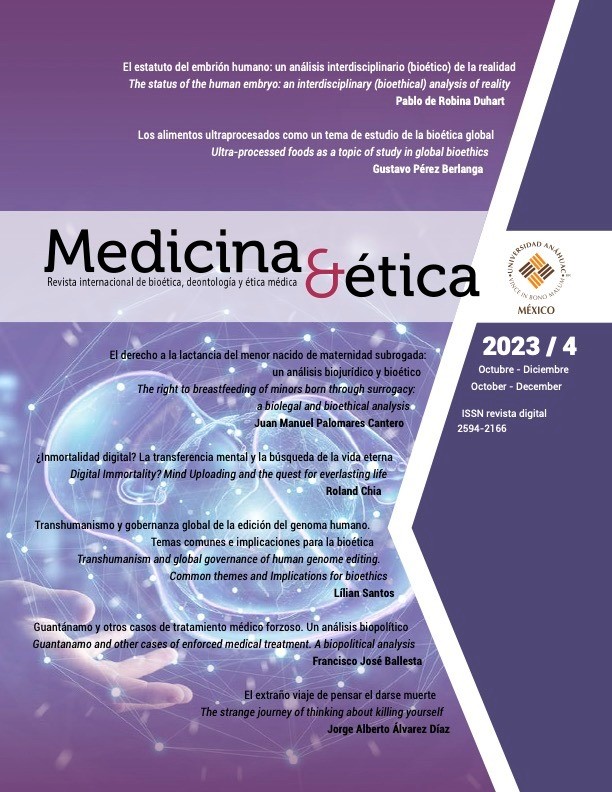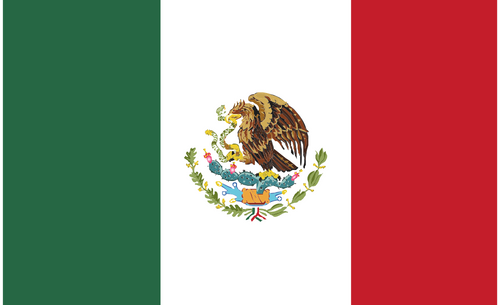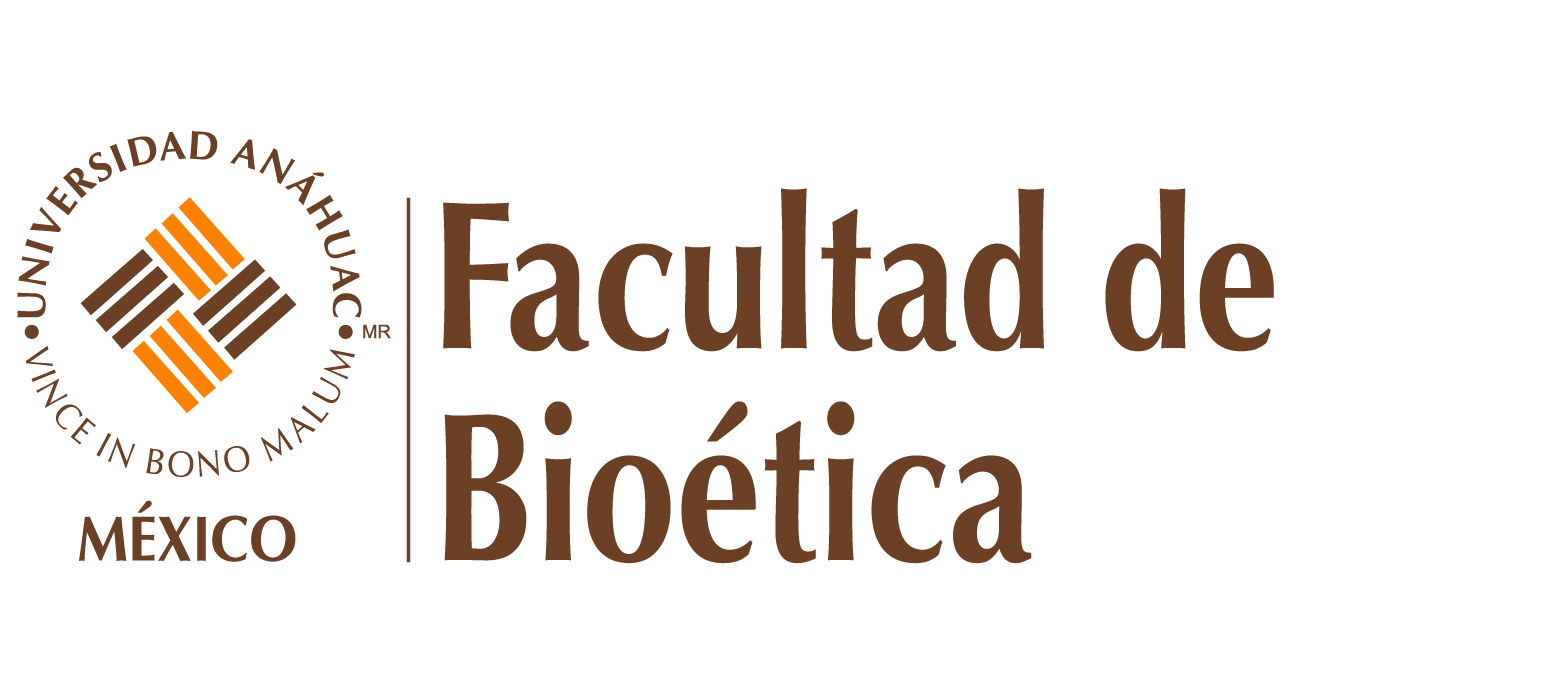Los alimentos ultraprocesados como un tema de estudio de la bioética global
DOI:
https://doi.org/10.36105/mye.2023v34n4.02Palabras clave:
alimentación y salud, enfermedades no transmisibles, bioéticaResumen
Este artículo propone considerar a la alimentación en general y a los ultraprocesados y bebidas azucaradas en lo particular, como un tema que atañe a la bioética global. La primera sección explica la relación entre el consumo de los alimentos ultraprocesados y la salud, la segunda, relaciona a las llamadas enfermedades no transmisibles y la salud mental con la alimentación y la tercera sección, argumenta el papel que debe jugar la bioética, en especial la global, en materia de alimentación.
Descargas
Referencias
Madrid J. Los pilares de la alimentación. Enf Global [Internet]. [cited 2023 Aug 29]; 6(2). Available at: https://revistas.um.es/eglobal/article/view/712
Popkin B. El impacto de los alimentos ultraprocesados en la salud. Organización de las Naciones Unidas para la Agricultura y la Alimentación. Reporte 34 [Internet]. 2020. Available at: https://www.fao.org/3/ca7349es/CA7349ES.pdf
Organización Panamericana de la Salud. Enfermedades no transmisibles [Internet]; 2020 [Citado 8 de abril de 2023]. Available at: https://www.paho.org/es/temas/enfermedades-no-transmisibles
Ten Have H. Global Bioethics, an introduction. London: Routledge; 2016. DOI: https://doi.org/10.4324/9781315648378
Fillis J. Encyclopedia of Bioethics. Foster Academics; 2015.
Organización Mundial de la Salud. Nutrition [Internet]. 2023 [cited 2023 Apr 7]. Available at:
https://www.who.int/health-topics/nutrition
Monteiro CA, Cannon G, Moubarac JC, Levy RB, Louzada M, Jaime P. The un Decade of Nutrition, the NOVA food classification and the trouble with ultra-processing. Public Health Nutrition. 2018; 21(1):5-17. http://dx.doi.org/10.1017/S1368980017000234 DOI: https://doi.org/10.1017/S1368980017000234
Nardocci M, Leclerc B, Louzada M, Monteiro CA, Batal M, Moulbarac J. Comsuption of ultra-processed foods and obesity in Canada. Canadian Journal of Public Health. 2019; 110(1):4-14. http://dx.doi.org/10.17269/s41997-018-0130-x DOI: https://doi.org/10.17269/s41997-018-0130-x
Clave D. Consumo de alimentos y bebidas ultraprocesados en América Latina: tendencias, impacto en obesidad e implicaciones de política pública [Internet]. [cited 2023 Mar 18]. Available at: https://iris.paho.org/bitstream/handle/10665.2/7698/9789275318645_esp.pdf
Organización Mundial de la Salud. Directriz: ingesta de azúcares en adultos y niños [Internet]. 2015 [cited 2023 Apr 1]. Available at: https://apps.who.int/iris/bitstream/handle/10665/154587/WHO_NMH_NHD_15.2_spa.pdf
Instituto Nacional de Salud Pública. El consumo de azúcar en México y la nueva directriz de la OMS para su reducción global [Internet] [cited 2023 Apr 7]. Available at: https://www.insp.mx/epppo/blog/3609-consumo-azucar-mexico-nueva-directriz-oms.html
Cabezas C, Hernández B, Vargas-Zárate M. Azúcares adicionados a los alimentos: efectos en la salud y regulación mundial. Revisión de la literatura. Rev. Fac. Med. Univ. Nac. Colombia. 2016; 64(2):319. http://dx.doi.org/10.15446/revfacmed.v64n2.52143 DOI: https://doi.org/10.15446/revfacmed.v64n2.52143
Institute of Medicine. Dietary reference intakes for energy, carbohydrate, fiber, fat, fatty acids, cholesterol, protein, and aminoacids (macronutrients). Washington: National Academy Press; 2005.
Arias D, Ángel N, Arenas M, Ariza D, Aldana D, Arango M, Amador M, Mora M, Gómez L. Grasa y aceites provenientes de la dieta: consideraciones para su consumo en la población colombiana. Universidad Médica. 2022; 63(1):21-34. https://doi.org/10.11144/Javeriana.umed63-1.gras DOI: https://doi.org/10.11144/Javeriana.umed63-1.gras
Cabezas C, Hernández B, Vargas-Zárate M. Aceites y grasas: efectos en la salud y regulación mundial. Rev. Fac. Med. Univ. Colombia. 2016; 64(4):761. https://doi.org/10.15446/revfacmed.v64n4.53684 DOI: https://doi.org/10.15446/revfacmed.v64n4.53684
Organización Mundial de la Salud. Una fórmula para una buena salud: tiremos las grasas trans y ofrezcamos opciones saludables a la población [Internet]. 2023 [cited 2023 Apr 25]. Available at: https://www.who.int/es/news-room/commentaries/detail/a-recipe-for-good-health--banish-trans-fat-to-history-s-dust-bin-and-offerpeople-healthy-options
Argüelles J, Nuñez P, Perillán C. Excesive consumption of salt and hypertension: implications for public health. Rev Mex Trastor Aliment.2018; 9(1):119-28. https://doi.org/10.22201/fesi.20071523e.2018.1.466 DOI: https://doi.org/10.22201/fesi.20071523e.2018.1.466
Monckeberg B. La sal es indispensable para la vida, ¿pero cuanta? Rev Chil Nutr. 2012; 39(4):192-195. Available at: https://biblat.unam.mx/es/revista/revista-chilena-de-nutricion/articulo/la-sal-es-indispensable-para-la-vida-pero-cuanta
Organización Panamericana de la Salud. Reducción de la sal [Internet]. [cited 2023 Apr 24]. Available at: https://www.paho.org/es/temas/reduccion-sal
Organización Mundial de la Salud. Aditivos alimentarios [Internet]. [cited 2023 Apr 23]. Available at:
https://www.who.int/es/news-room/fact-sheets/detail/food-additives
Grimm H. Química en la comida. Mexico: Editorial Sirio; 2018.
Velázquez G, Collado R, Cruz R, Velasco A, Rosalez J. Hypersensivity reactions to food additives. Rev Alerg Mex. 2019; 66(3):329-339. http://dx.doi.org/10.29262/ram.v66i3.613 DOI: https://doi.org/10.29262/ram.v66i3.613
Trasande L, Shaffer R, Sathyanarayana S. Food additives and child health. Council on Environmental Health. 2018; 142(2). https://doi.org/10.1542/peds.2018-1408 DOI: https://doi.org/10.1542/peds.2018-1410
Organización Mundial de la Salud. Obesidad y sobrepeso [Internet]. [cited 2023 Apr 27]. Available at:
https://www.who.int/es/news-room/fact-sheets/detail/obesity-and-overweight
Galvez A. Comer con el TLC. Mexico: Fondo de Cultura Económica; 2022.
World Obesity Federation. World Obesity Atlas 2023. wof; 2023.
Martí del Moral A, Calvo C, Martínez A. Ultra-processed food consumption and obesity-A systematic review. Nutr Hosp. 2021; 38(1):177-185. https://doi.org/10.20960/nh.03151 DOI: https://doi.org/10.20960/nh.03151
Arteaga A. El sobrepeso y la obesidad como un problema de salud. Rev Médica Clin Las Condes. 2012; 23(2):145-153. https://doi.org/10.1016/S0716-8640(12)70291-2 DOI: https://doi.org/10.1016/S0716-8640(12)70291-2
Heredia M, Gallegos E. Riesgo de diabetes mellitus tipo 2 y sus determinantes. Enfer Glob. 2022; 21(1):179-202. https://dx.doi.org/10.6018/eglobal.482971 DOI: https://doi.org/10.6018/eglobal.482971
Alcántara-Ortiz M, Campos J, Ibarra A. Desregulación metabólica y consecuencias clínicas por el consumo de fructuosa. TIP Revista especializada en ciencias químicas biológicas. 2021; 24. https://doi.org/10.22201/fesz.23958723e.2021.332 DOI: https://doi.org/10.22201/fesz.23958723e.2021.332
Organización Mundial de la Salud. Las 10 principales causas de defunción [Internet]. [cited 2023 Apr 23]. Available at: https://www.who.int/es/news-room/factsheets/detail/the-top-10-causes-of-death
Viola L, Noel G, Defagó M. De nutrientes a patrones alimentarios: cambios de paradigma en el abordaje nutricional de las enfermedades cardiovasculares. Perspect Nutr Humana. 2020; 22(1). https://doi.org/10.17533/udea.penh.v22n1a08 DOI: https://doi.org/10.17533/udea.penh.v22n1a08
Fernández A, Martínez R, Carrasco I, Palma A. Impacto social y económico de la doble carga de la malnutrición: modelo de análisis y estudio piloto en Chile, el Ecuador y México. Comisión Económica para América Latina y el Caribe; 2017.
Bordonada C. Nutrición en salud pública [Internet]. [cited 2023 Apr 8]. Available at: https://www.academia.edu/66952192/Nutrici%C3%B3n_en_Salud_P%C3%-BAblica
Melo B, Rezende L, Machado P, Gouveia N, Lecy R. Associations of ultra-processed food and drink products with asthma and wheezing among Brazilian adolescents. Pedriatr Allergy Immunol. 2018; 29(5):504-511. https://doi.org/10.1111/pai.12911 DOI: https://doi.org/10.1111/pai.12911
Moreno L, Martin I, Fernández A, Santos B, Ciriza E, Martin M. Consumo de productos ultraprocesados y enfermedades respiratorias sibilantes en niños. An Pedriatr (Barc). 2021; 95(1):18-25. https://doi.org/10.1016/j.anpedi.2020.05.021 DOI: https://doi.org/10.1016/j.anpedi.2020.05.021
Organización Mundial de la Salud. who.int. [Internet]. [cited 2023 Apr 8]. Available at: https://www.who.int/es/health-topics/cancer
Castelló A, Pollán M. Alimentación y nutrición para la prevención del cáncer. Nutrición en Salud Pública; 2021.
Mora G Emilia, Moschella Filomena, Navarro Dianora, Reyes Eibys, Vargas Maurielkys. Dieta, estado nutricional y riesgo de cáncer. Arch Venez Puer Ped [Internet]. 2014 [cited 2023 Aug 29]; 77(4): 202-209. Available at:
http://ve.scielo.org/scielo.php?script=sci_arttext&pid=S0004-06492014000400007&lng=es
Organización Mundial de la Salud. El Centro Internacional de Investigaciones sobre el Cáncer evalúa el consumo de la carne roja y de la carne procesada. [Internet]. 2015 [cited 2023 Apr 8]. Available at:
https://apps.who.int/mediacentre/news/releases/2015/cancer-red-meat/es/index.html
Fiolet T, Srour B, Sellem L, Kesse-Guyot E, Alles B, Mejean C. Consumption of ultra-processed foods and cancer risk: results from NutriNet-Santé prospective cohort. BMJ. 2018; 360(322). https://doi.org/10.1136/bmj.k322 DOI: https://doi.org/10.1136/bmj.k322
Organización Mundial de la Salud. Salud mental: un estado de bienestar [Internet]. 2019 [cited 2023 Apr 27]. Available at: https://www.who.int/features/factfiles/mental_health/es/
American Phychological Association. ¿Que es la salud mental? [Internet]. 2021 [cited 2023 Apr 8] Available at: https://www.apa.org/topics/mental-health
Asociación Española. ¿Qué es la salud mental? [Internet]. 2019 [cited 2023 Apr 8]. Available at: https://www.asesp.com.uy/Servicios/Salud-Mental-uc203
Organización Mundial de la Salud. Día Mundial de la Salud Mental [Internet]. 2023 [cited 2023 Apr 8]. Available at: https://www.who.int/es/campaigns/world-mentalhealth-day
Diez-Canseco F, Ipince A, Toyama M, Benate-Galvez Y, Galán-Rodas E, Medina-Verástegui J. Atendiendo la salud mental de las personas con enfermedades crónicas no transmisibles en el Perú: retos y oportunidades para la integración de cuidados en el primer nivel de atención. Rev. perú. med. exp. salud publica [Internet]. 2014 [cited 2023 Aug 29]; 31(1):131-136. Available at: https://medes.com/publication/168979 DOI: https://doi.org/10.17843/rpmesp.2014.311.19
Organización Mundial de la Salud. La salud mental y el uso de sustancias [Internet]. [cited 2023 Apr 9]. Available at: https://www.who.int/teams/mental-health-and-substance-use
Centers for Disease Control and Prevention. Acerca de la salud mental. [Internet]. 2021 [cited 2023 Apr 8] Available at: https://www.cdc.gov/mentalhealth/learn/index.htm
Jacka F, Pasco J, Mylteun A, Williams L, Hodge A, O´Reilly S. Association of western and traditional diets with depression and anxiety in women. The American Journal of Psychiatry. 2010; 167(3):305-311. https://doi.org/10.1176/appi.ajp.2009.09060881 DOI: https://doi.org/10.1176/appi.ajp.2009.09060881
Opie R, O´Neil A, Jacka F, Pizzinga J, Itsiopoulos C. A modified Mediterranean dietary intervention for adults with major depressión: Dietary protocol and feasibility data from the SMILES trial. Nutr Neurisci. 2018; 7:487-501. https://doi.org/10.1080/1028415X.2017.1312841 DOI: https://doi.org/10.1080/1028415X.2017.1312841
Pino G. Alimentos industrializados: una oferta de productos “deficientes” para el cerebro del consumidor [Internet]. 2022 [cited 2023 Apr 8]. https://www.researchgate.net/publication/358984841_Alimentos_industrializados_Una_oferta_de_productos_deficientes_para_el_cerebro_del_consumidor/link/6220f0ceadd1b367ae1107df/download
Jacques A, Chaaya N, Beecher K, Auon S, Belmer A. The impact of sugar consumption on stress driven, emotional and addictive behaviors. Neuroscience and Biobehavioral Reviews. 2019; 1:178-199. https://doi.org/10.1016/j.neubiorev.2019.05.021 DOI: https://doi.org/10.1016/j.neubiorev.2019.05.021
Lopresti A, Hood S, Drummond P. A review of lifestyle factors that contribute to important pathways associated with major depression: diet, sleep, and exercise. J Affect Disord. 2013; 148(1):12-27. https://doi.org/10.1016/j.jad.2013.01.014 DOI: https://doi.org/10.1016/j.jad.2013.01.014
Organización Mundial de la Salud. Sugars intake for adults and children, 394. [Internet]. 2015 [cited 2023 Apr 28]. Available at: https://www.who.int/publications/i/item/9789241549028
Malik V, Hu F. Sweeteners and risk of obesity and type 2 diabetes: the role of sugar-sweetened beverages. Curr Diab Rep. 2012; 12(5):195-203. https://doi.org/10.1007/s11892-012-0259-6 DOI: https://doi.org/10.1007/s11892-012-0259-6
Stanhope K. Sugar consumption, metabolic disease and obesity: The state of the controversy. Crit Rev Clin Lab Sci. 2016; 53(1):52-67. https://doi.org/10.3109/10408363.2015.1084990 DOI: https://doi.org/10.3109/10408363.2015.1084990
Morenga TE, Mallard S, Mann J. Dietary sugars and body weight: systematic review and meta-analyses of randomised controlled trials and cohort studies. BMJ. 2013; 346:e7492.https://doi.org/10.1136/bmj.e7492 DOI: https://doi.org/10.1136/bmj.e7492
Johnson R, Nakagawa T, Sánchez-Lozada L, Schafiu M, Sundaram S, Le M. Sugar, Uric Acid, and the Etiology of Diabetes and Obesity. Diabetes. 2013; 62(11):3307-3315. https://doi.org/10.2337/db12-1814 DOI: https://doi.org/10.2337/db12-1814
Malik V, Popkin B, Bray G, Després J, Willet W, Hu F. Sugar-Sweetened Beverages, Obesity, Type 2 Diabetes Mellitus, and Cardiovascular Disease Risk. Circulation. 2010; 121(11):1356-1364. https://doi.org/10.1161/CIRCULATIONAHA.109.876185 DOI: https://doi.org/10.1161/CIRCULATIONAHA.109.876185
Organización Mundial de la Salud. World Health Organization. Sodium intake for adults and children, 394. [Internet]. 2016 [cited 2023 Apr 10]. Available at: https://www.who.int/news-room/fact-sheets/detail/salt-reduction
He FJ, MacGregor GA. Salt intake, hypertension and cardiovascular disease: why are the guidelines so different? Br J Sports Med. 2015 Junio; 49(11):677-679. https://doi.org/10.1016/j.jacc.2019.11.055 DOI: https://doi.org/10.1016/j.jacc.2019.11.055
Graudal NA, Hubeck-Graudal T, Jürgens G. Effects of low sodium diet versus high sodium diet on blood pressure, renin, aldosterone, catecholamines, cholesterol, and triglyceride. Database Syst Rev. 2011;(11): 4022. https://doi.org/10.1002/14651858.CD004022.pub3 DOI: https://doi.org/10.1002/14651858.CD004022.pub3
He FJ, Li J, MacGregor GA. Effect of longer-term modest salt reduction on blood pressure. Cochrane Database Syst Rev. 2013; 30(4). https://doi.org/10.1002/14651858.CD004937 DOI: https://doi.org/10.1002/14651858.CD004937.pub2
O´Donnell MJ, Mente A, Rangarajan S, McQueen MJ, Wang X, Liu L. Urinary sodium and potassium excretion, mortality, and cardiovascular events. New England Journal Medicine. 2014; 371(7):612-623. https://doi.org/10.1056/NEJMoa1311889 DOI: https://doi.org/10.1056/NEJMoa1311889
Organización Mundial de la Salud. Saturated fatty acid and trans-fatty intake for adults and children [Internet]. 2018 [cited 2023 Apr 22]. Available at: https://www.who.int/publications/i/item/9789240073630
American Heart Association. Saturated Fats [Internet]. 2017 [cited 2023 Apr 22]. Available at:
https://www.heart.org/en/healthy-living/healthy-eating/eat-smart/fats/saturated-fats
Schwingshackl L, Bogensberger B, Bencic A, Knuppel S. BoeDietary fatty acids in the secondary prevention of coronary heart disease: a systematic review, meta-analysis and network meta-analysis. Public Health Nutrition. 2020; 23(7):1239-1253. https://doi.org/10.1136/bmjopen-2013-004487 DOI: https://doi.org/10.1136/bmjopen-2013-004487
World Cancer Research Fund International/American Institute for Cancer Research. Diet, Nutrition, Physical Activity and Cancer: a Global Perspective. Continuous Update Project Expert Report [Internet]. 2018 [cited 2023 Apr 12]. Available at: https://www.wcrf.org/dietandcancer
World Health Organization. Saturated fatty acid and trans-fatty intake for adults and children. [Internet]. 2018 [cited 2023 Apr 22]. Available at: World Health Organization. (2018). https://www.who.int/publications/i/item/9789240073630
Organización Mundial de la Salud. Directrices de la oms sobre la ingesta de grasas y ácidos grados en adultos [Internet]. 2018 [cited 2023 Apr 22]. Available at: https://www.who.int/es/news/item/14-05-2018-who-plan-to-eliminate-industriallyproduced-trans-fatty-acids-from-global-food-supply
Mozaffarian D, Katan MB, Ascherio A, Stampfer MJ, Willett WC. Trans Fatty Acids and Cardiovascular Disease. New England Journal of Medicine. 2006; 354(15):1601-1613. https://doi.org/10.1056/NEJMra054035 DOI: https://doi.org/10.1056/NEJMra054035
Micha R, Mozaffarian D. Trans fatty acids: effects on metabolic syndrome, heart disease and diabetes. Nature Reviews Endocrinology. 2008; 5(6):335-344. https://doi.org/10.1038/nrendo.2009.79 DOI: https://doi.org/10.1038/nrendo.2009.79
Chajes V, Thiebaut AC, Rotival M, Gauthier E, Maillard V, Boutron-Ruault MC. Association between Serum Trans-Monounsaturated Fatty Acids and Breast Cancer Risk in the E3N-EPIC Study. American Journal of Epidemiology. 2008; 167(10):1312-1320. https://doi.org/10.1093/aje/kwn069 DOI: https://doi.org/10.1093/aje/kwn069
European Food Safety Authority. Risks for human health related to the presence of 3 and 2monochloropropanediol (MCPD), and their fatty acid esters, and glycidyl fatty acid esters in food. efsa Journal. 2017; 15(5):e04752. https://doi.org/10.2903/j.efsa.2016.4426 DOI: https://doi.org/10.2903/j.efsa.2016.4426
Mozaffarian D, Aro A, Willet WC. Health effects of trans-fatty acids: experimental and observational evidence. European Journal of Clinical Nutrition. 2009; 63:S5-S21. https://doi.org/10.1038/sj.ejcn.1602973 DOI: https://doi.org/10.1038/sj.ejcn.1602973
O´Mahony M, Clarke G, Borre YE. Serotonin, tryptophan metabolism and the brain-gut-microbiome axis. Behavioural brain research; 277(32-48). https://doi.org/10.1016/j.bbr.2014.07.027 DOI: https://doi.org/10.1016/j.bbr.2014.07.027
Schmidt CW. Growing a New Study: Environmental Influences on Child Health Outcomes. 2015; 123(7):A168. https://doi.org/10.1289/ehp.123-A260 DOI: https://doi.org/10.1289/ehp.123-A260
McCann D, Barrett A, Cooper A. Food additives and hyperactive behaviour in 3-year-old and 8/9-year-old children in the community: a randomised, double-blinded, placebo-controlled trial. Lancet. 2007; 9598:1560-1567. https://doi.org/10.1016/S0140-6736(07)61306-3 DOI: https://doi.org/10.1016/S0140-6736(07)61306-3
Stevens LJ, Juczek T, Burgess JR. Mechanisms of behavioral, atopic, and other reactions to artificial food colors in children. Nutr Rev. 2013; 71(7):268-281. https://doi.org/10.1111/nure.12023 DOI: https://doi.org/10.1111/nure.12023
Reich WT. Encyclopedia of Bioethics. New York: Free Press-MacMillan; 1978.
Reich WT. Encyclopedia of Bioethics. New York: Free Press-MacMillan; 1995. DOI: https://doi.org/10.2307/2137793
Organización Mundial de la Salud, Organización de las Naciones Unidas para la Agricultura y Alimentación. Joint fao/who Expert Commitee on Food Additive.Ginebra: oms/fao; 2012. https://www.fao.org/home/es
Harvard University. Food system transformation needed for human and planetary health. [Internet]. 2019 [cited 2023 mar 30]. Available at: https://www.hsph.harvard.edu/news/features/food-transformation-human-planetary-health/

Descargas
Publicado
Número
Sección
Licencia
Derechos de autor 2023 Gustavo Pérez Berlanga

Esta obra está bajo una licencia internacional Creative Commons Atribución-NoComercial-CompartirIgual 4.0.
Medicina y Ética se distribuye bajo Licencia Creative Commons Atribución-NoComercial-CompartirIgual 4.0 Internacional.
El autor conserva los derechos patrimoniales sin restricciones y garantiza a la revista el derecho de ser la primera publicación del trabajo. El autor es libre de depositar la versión publicada en cualquier otro medio, como un repositorio institucional o en su propio sitio web.



























